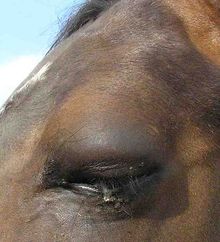With horses facing high risks of developing eye problems because of their prominent eyes and the environment in which they live, Cornell clinicians have developed a new way to detect and diagnose problems with horse's eyes more safely and quickly.

Diagnosing and treating horse eye problems
Horses with microscopic foreign objects in their eyes can benefit from a new diagnostic technique developed by researchers at Cornell University that lets doctors take pictures of living eyes in microscopic detail.
Published online in January 2014 in the journal Veterinary Ophthalmology, their findings are the first to show how horses with microscopic foreign objects in their eyes can benefit from in vivo corneal confocal microscopy, a human medicine technique that lets doctors take pictures of living eyes in microscopic detail without a scratch.
After veterinary ophthalmologist Dr. Eric Ledbetter began adapting the technique in feline and canine patients at Cornell University Hospital for Animals, where he discovered two new infectious diseases of the eye that had never been described before, he expanded to other species.
He became the first to use the technique to examine horses, pioneering a clinical research program to develop and validate non-invasive eye imaging in a species particularly poised to benefit from it.
Because of the ways horse's eyes are situated and because of the environment in which they live, eye trauma is common and causes a number of problems including fungal infections of the cornea, as well as scratches, embedding of microscopic pieces of debris and other trauma to their eyes.
Using an in vivo corneal confocal microscope with a focal depth of 1.5mm he adapted for use on horses, Ledbetter demonstrated its ability to repeatedly examine and take images all the way through a horse’s 1mm-thick cornea— the eye’s first line of defense and a frequent site of injury and infection.
Unlike traditional methods of eye imaging, confocal microscopy gets immediate results without needing a biopsy or any other kind of surgery.
Ledbetter has used it in clinics to help find and characterize tumors, scratches, foreign bodies, infections, immune-mediated ocular diseases, and other eye problems.
By collecting images of horses’ eyes with foreign bodies and comparing them to results from traditional biopsy-based diagnostic methods like cytology and histopathology, he validated confocal microscopy as a quicker non-invasive technique to image and diagnose this eye problem accurately.
By concurrently using both this new and preexisting techniques, this research has paved the way for veterinarians to definitively diagnose eye diseases in horses by using this new technology which minimizes the impact on the eye and saves time in determining and beginning the best treatment for the eye problem.
